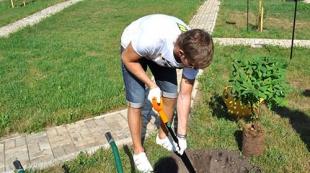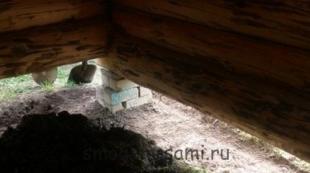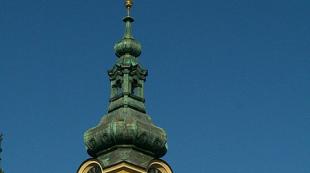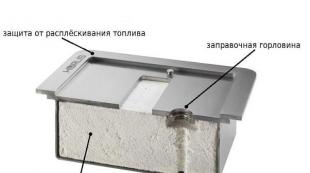Honeysuckle Altai. Honeysuckle is edible. The best sweet varieties
Honeysuckle Altai- shrub up to 1 - 1.5 m high with a dense crown. The bark of old branches is brownish-gray, in some places longitudinally exfoliating, young ones are reddish. The leaves are short-haired, oblong-elliptical, 3-7 cm long, wedge-shaped or rounded at the base, and blunt or shortly pointed at the apex. Stipules of opposite leaves sometimes fused in pairs. The flowers are pale yellow, bell-shaped, blooming at the ends of fruitful branches, paired with subulate bracts fused at the base. Fruits growing at the ends of fruit-bearing twigs, oval or ovoid, often doubled, black-blue or bluish from a wax coating. Bitter-sweet, reminiscent of the taste of blueberries and blueberries. Blooms in the second half of May - early August; bears fruit in the second half of July - August.
Common within the temperate zone of the entire Northern Hemisphere. Widely distributed in Western and Eastern Siberia, the Urals and Altai, the Sayan Mountains, the Far East, Kazakhstan and Mongolia. Grows on shikshevniks, in forests, in the undergrowth of various forests of the taiga zone, in riverine meadows, in thickets of bushes, in tussocky blueberry-brush tundras. In mountainous areas it occurs on open slopes, among rocks and stony placers, sometimes above the forest belt. Introduced into the culture of selected forms, in the berries of which there is no bitterness. The plant is cultivated in gardens for its berries and for ornamental purposes.
Harvest Altai honeysuckle berries in the period of full maturity, from the second half of July to August. The berries are picked by hand and used fresh or jam is made, sometimes dried. Altai honeysuckle fruits contain a significant amount of ascorbic acid, organic acids, terpenoids, vitamin P, tannins, catechins, luteolin 7-glucoside flavonoid, anthocyanins (3-rutinoside cyanidine, chrysanthemum, cyanidin), leukoanthocyanins.
In folk medicine honeysuckle berries fresh or in the form of jam with tea, less often - an infusion of dried berries is used as an antihypertensive agent for the treatment of hypertension; they are recommended for disorders of the gastrointestinal tract, peptic ulcer of the stomach and duodenum, beriberi C, anemia, malaria, as a diuretic for dropsy and other edema, mainly of cardiovascular origin, for atherosclerosis, diarrhea, colitis, as a tonic and restorative means to improve memory. The ability of fruits to increase the secretion of gastric juice and the digestive capacity of gastric juice has been experimentally established. The fruits also have anti-inflammatory, astringent, antispasmodic action.
Sometimes juice from fresh berries and the berries themselves, previously crushed, are used as an external remedy for eczema and other skin diseases, as well as for inflammatory diseases of the oral cavity, for gingivitis, stomatitis.
Fruit edible fresh and dried, used to make jelly, jam, juice. Fruits in Mongolia are consumed in a candied form and for flavoring tea.
Branches, leaves, flowers are also used for medicinal purposes. Organic acids, vitamin C, tannins, luteolin 7-glucoside flavonoid (glucoluteolin), anthocyanins (chrysanthemum, cyanidin) were found in branches and leaves.
Leaves possess antibacterial and protistocidal activity. Infusion of leaves is prescribed for metabolic disorders, for gout. A decoction of leaves and flowers is used for rinsing with laryngitis, eye diseases, dermatosis. A decoction of the bark in Tibetan medicine is used for polyarthritis, headaches, a decoction of the branches and bark is sometimes prescribed for dropsy.
Related Articles
Features of planting honeysuckle in Siberia
 The move for edible honeysuckle is quite simple. It is enough to follow a few simple rules in order to reap a good harvest in a few years.
The move for edible honeysuckle is quite simple. It is enough to follow a few simple rules in order to reap a good harvest in a few years.
In folk medicine, not only honeysuckle berries are used, but also its leaves, flowers and stems. So, a decoction of the leaves of a shrub cures inflammation of the gums and sore throat.
- http://www.greeninfo.ru/fruits/lonicera.html/Article/_/aID/5486
- LAURA - a variety of edible honeysuckle bred at VNIIR them. N.I.Vavilova (St. Petersburg). The bush is medium-sized, with a dense back-conical shape, 1.5 m high. The fruits are spindle-shaped with a pointed top, a strong wax coating. Fruit weight - 0.6-0.8 gr. The taste is best sweet, the pulp is tender. Edible honeysuckle variety of medium-early ripening.
BEREL - a variety of edible honeysuckle obtained at the NIISS named after. M.A. Lisavenko (Barnaul). The bush is tall, vigorous. Very fruitful. The best productive variety. Pear-shaped fruits with an uneven surface, 2.1 cm long. Fruit weight - 0.8-1.2 g. The fruits do not fall off. The taste is sour-bitter, the skin is dense. Edible honeysuckle variety of medium ripening.
- helps to overcome stress, nervousness
- L.), with yellowish, almost regular flowers and bluish berries, each formed from a pair of fused fruits; the northernmost European, not wildly caught in Russia, but bred, - Curly honeysuckle (
- Quite large flowers (white, pinkish, yellowish and blue) are often located in pairs in the corners of leaves or at the ends of branches in capitate inflorescences. An irregular (in the majority) tubular corolla emerges from a poorly developed calyx, divided into five lobes at the end; the irregularity of the colors built according to the five plan depends on the fusion of the three front petals and their uneven development, as a result of which the corolla is
- Mulch the trunk circle of the bush with spruce or pine branches, coniferous branches are the best protection against rodents and good organic top dressing;
- It is better to start feeding in a year, in small doses, after abundant watering.
- For many residents of Siberia, an early tasty berry grown in their summer cottage is a real luxury. But not for those who grow honeysuckle and have already managed to enjoy all the advantages of this fragrant berry. In the conditions of the arrival of late spring, it ripens in mid-June, when raspberries, strawberries, currants are just budding.
- 1. The first thing to remember is regular watering. Every day you should water the bush with 1-1.5 buckets of water. In summer, the volume of water per plant can be increased to two buckets.
(3 tablespoons of dry honeysuckle leaves should be boiled for 3 minutes in 200 water, cool, let it brew for 2 hours, strain and gargle with sore throat)
 Scientists breed varieties and there are rules for which varieties are more suitable for a better harvest, not all varieties produce good berries and not all varieties are suitable for pollination. It’s a pity that you don’t remember the varieties of your honeysuckle, but when the harvest appears, you can determine! I can send selected articles about honeysuckle to your address, but you can always search on Google or Yandex yourself, there is a lot of information in Russian, although many sites simply impudently copy articles without referring to the source, so there are a lot of "doubles."
Scientists breed varieties and there are rules for which varieties are more suitable for a better harvest, not all varieties produce good berries and not all varieties are suitable for pollination. It’s a pity that you don’t remember the varieties of your honeysuckle, but when the harvest appears, you can determine! I can send selected articles about honeysuckle to your address, but you can always search on Google or Yandex yourself, there is a lot of information in Russian, although many sites simply impudently copy articles without referring to the source, so there are a lot of "doubles."
Secrets of honeysuckle: subtleties of care and successful wintering
 LENITA - a variety of edible honeysuckle obtained at the South Ural Research Institute of Horticulture and Potato Growing (Chelyabinsk). The bush is vigorous with thin shoots. The fruits are elongated-ellipsoid. Fruit weight - 1.0 gr. The taste is the best sweet, fragrant. Edible honeysuckle variety of medium ripening.
LENITA - a variety of edible honeysuckle obtained at the South Ural Research Institute of Horticulture and Potato Growing (Chelyabinsk). The bush is vigorous with thin shoots. The fruits are elongated-ellipsoid. Fruit weight - 1.0 gr. The taste is the best sweet, fragrant. Edible honeysuckle variety of medium ripening.
FIRE OPAL - a variety of edible honeysuckle obtained at the NIISS them. M.A. Lisavenko (Barnaul). The bush is vigorous with a densely branched crown, 1.8 m high. Very productive. The fruits are elongated-oval, 1.6 cm long. Fruit weight - 0.8-1.0 g. The taste is sour-bitter, the skin is dense. Edible honeysuckle variety of late ripening.
- Lonicera periclymenum
- two-lipped
- The lower shoots should be spudded with earth.
 Several varieties of honeysuckle in one area can significantly increase the yield.
Several varieties of honeysuckle in one area can significantly increase the yield.
Skeptic gardeners have long believed that planting honeysuckle in Siberian summer cottages is an empty undertaking. Their vowel argument is that the cultivated species of this plant will die in cold winter conditions and it is better to be content with wild forms that are widespread in Siberian forests. Well, those who decided to take a chance and planted honeysuckle from the Siberian series in the garden can confidently confirm that this shrub can withstand temperatures up to -45-50 degrees and is practically not damaged by repeated frosts.
- 2. Once a year in the summer it is necessary to deoxidize the pear (1 liter of ash per 1 bucket of water).
- helps to get rid of constipation. Crushed honeysuckle leaves will heal festering wounds and ulcers on the surface of the skin. A decoction of the flowers of the plant will relieve a headache, relieve dizziness.
- I have been growing honeysuckle for many years. I also think that in principle any variety is suitable. But there is one "but". This is always true if spring comes quickly in your region, immediately warm, then the honeysuckle varieties bloom together and the difference between the beginning of flowering of early and late varieties is 3-5 days and does not affect pollination. But if you have long, cold springs, then the difference in flowering time can be more noticeable, then you need to plant in groups - those that bloom at the same time - either early, or middle, or late. Contact the Bakcharsky nursery, Tomsk region (there is a website), there are the best varieties of honeysuckle at the moment, and inexpensively - 50 rubles for a 2-year-old, but they even sent me half of the three-year-olds - gorgeous seedlings and everyone started.
SLAVYANKA - a variety of edible honeysuckle bred at VNIIR them. N.I.Vavilova (St. Petersburg). The bush is vigorous, with a dense back-conical shape, 1.9 m high. The fruits are large, broadly fusiform with a rounded top and a narrow base, 2.3 cm long. Fruit weight - 0.8 g. The taste is best sweet with a delicate aroma. The variety in aggregate is the best large-fruited and the best sweet. Edible honeysuckle variety of medium ripening.
Honeysuckle in Siberia: the best varieties
 SELENA - a variety of edible honeysuckle obtained at the NIISS them. M.A. Lisavenko (Barnaul). Bush of medium size with a dense oval crown. Also the best yielding variety. Drop-shaped fruits, 1.8 cm long. Fruit weight - 0.8-1.0 g. The fruits do not fall off. The taste is sour-bitter, the skin is dense. Edible honeysuckle variety of late ripening.
SELENA - a variety of edible honeysuckle obtained at the NIISS them. M.A. Lisavenko (Barnaul). Bush of medium size with a dense oval crown. Also the best yielding variety. Drop-shaped fruits, 1.8 cm long. Fruit weight - 0.8-1.0 g. The fruits do not fall off. The taste is sour-bitter, the skin is dense. Edible honeysuckle variety of late ripening.
- We present the best varieties of edible honeysuckle. The best sweet large-fruited varieties of edible honeysuckle.
- L.), in which the leaves never grow together (fat honeysuckle, fragrant fern). In horticulture, several more American species are known.
- ; there are five stamens and a long pistil in the corolla tube.
There is one simple and effective answer to the question of how to prepare honeysuckle for winter: timely disease prevention, proper care strengthen honeysuckle's immunity and help it winter without loss and stress.
After planting, further care for honeysuckle consists in weeding, watering, as the soil dries out and preventive work. It is important not to overdo the fertilization. This can lead to the death of the plant or severe exposure of the lower part of the trunk.
 In order for the plant to successfully develop and bear fruit in the conditions of the cold Siberian climate, you need to know how to properly plant honeysuckle so that it quickly acclimatizes:
In order for the plant to successfully develop and bear fruit in the conditions of the cold Siberian climate, you need to know how to properly plant honeysuckle so that it quickly acclimatizes:
3. It is important not to forget about fertilizer. In late autumn, honeysuckle should be fertilized with the following composition: mix 100 g of ash with 5 kg of compost and 40 g of double superphosphate. In the spring, you can “feed” the plant with saltpeter at the rate of 15 g per 1 square meter.
Video about honeysuckle
glav-dacha.ru
Honeysuckle - Wikipedia.
Distribution and ecology
Branches and leaves of honeysuckle are harvested in May during flowering, bark in the autumn, honeysuckle fruits - when ripe.
Botanical description
On the site sad-i-ogorod.ru NGO Gardens of Russia you can see, there the best variety is written for each variety - a pollinator. SWEET - a variety of edible honeysuckle obtained at the Kamchatka Research Institute of Agriculture. The bush is medium-sized, compressed. Fruits are oblong-oval, weighing 1.0 g. The taste is sweet with a slight sourness, with aroma. Edible honeysuckle variety of medium ripening. BAKCHARSKY GIANT - a variety of edible honeysuckle bred at the Bakcharsky stronghold of the NIISS (Tomsk region). The bush is sparse with an oval crown, vigorous up to 1.9 m. The fruits are very large, elongated-cylindrical, up to 4.0 cm long. The best among large-fruited varieties of edible honeysuckle. Fruit weight 1.8-2.0 gr. The taste is sweet and sour, delicate dessert. Edible honeysuckle variety of medium ripening.
In this article, we will look at those
In the Caucasus, Georgian honeysuckle is also known (
Significance and application
Berry fruits sit in pairs, and often grow together with each other.
If you choose the right reliable zoned honeysuckle varieties for Siberia, then summer will always begin with a tasty and fragrant berry. When choosing, you should be guided by such criteria as: Care for honeysuckle in Siberia is not much different from a similar process in another region of the country. A year after planting, the bushes should be regularly fed with complex fertilizers. But since the summer in this region is short, it is better to speed up the flow of nutrients to the roots. To do this, deep holes are made in the near-stem circle of the bush with a crowbar and a solution with microelements is poured into them. It is better to use nitrogen fertilizers only in early spring in minimal quantities, since the plant will not have time to completely absorb them during the short growing season. The dose of ammonium nitrate should not exceed 35 g per plant. Potassium and superphosphate are applied in spring and autumn at the rate of 30 g per bush. Choose only zoned varieties that are designed specifically for the Siberian region.
4. For the prevention of plant diseases and pest control, shrubs should be treated in the summer. If there are no pests on the shrub, then this procedure can be skipped.
As for contraindications, the shrub almost does not have them. Therefore, most reviews of edible honeysuckle are positive. If you use decoctions and drugs prepared strictly according to the recipe, then Recently, growing a very useful wild berry has become popular among gardeners -The material was prepared on the basis of the works of Kuklina A.G. – a professional in the field of systematization of honeysuckle varieties. VILIGA - a variety of edible honeysuckle obtained in the Moscow region by L.P. Kuminov. The bush is vigorous, up to 2.4 m high. The fruits are large-fruited, elongated. Fruit weight 1.2 gr. The taste is sweet and sour, delicate dessert. Edible honeysuckle variety of medium-early ripening. The best varieties of edible honeysuckle
Lonicera iberica The upper leaves in some species (and in others all) grow together, forming one common plate or wide rim, through which the end of the branch with flowers passes. high yield; Honeysuckle is a simple and easy-to-care plant. It quickly takes root on the site and gladly gives its fruits to people. Experienced gardeners have long found an approach to this plant and learned the secrets of honeysuckle, which will facilitate the care of the bushes and help increase the yield: For planting, three-year-old bushes in containers with an open root system are best suited. They are several times more expensive than annual seedlings, but more resistant to climatic conditions, will take root faster after transshipment and will delight you with delicious berries in the first year.
5. Do not forget to loosen the soil, remove weeds, saturating the honeysuckle root system with oxygen. Harm honeysuckle edible edible honeysuckle
So, you are presented PRIDE OF BAKCHAR - a variety of edible honeysuckle was bred at the Bakchar stronghold of the NIISS (Tomsk region). A bush with a spherical crown, medium height up to 1.6 m. The fruits are very large, elongated-fusiform, up to 4.0 cm long. The variety is also the best among large-fruited varieties of edible honeysuckle. Fruit weight 1.3 gr. The taste is sweet and sour, delicate dessert. A variety of honeysuckle edible early ripening. Which are most often of interest to gardeners for certain reasons. Namely: varieties of edible honeysuckle
en.wikipedia.org
Bieb.), with red-yellow flowers, and Caucasian honeysuckle (
Honeysuckle is edible. The best varieties.
Many types of honeysuckle are very often bred in gardens as beautiful ornamental shrubs, well suited for groups, alleys and arbors; Russian species bloom in early summer, that is, at the end of May and until mid-June. In Central Russia, it is quite often found along the edges of forests and in groves of Lonicera xylosteum L. - Real honeysuckle, or honeysuckle, or wolf berries with yellow-white flowers and red berries, the leaves are fluffy below. It is often bred in gardens, but does not grow wildly in southern Russia. good winter hardiness; Learn how to properly water honeysuckle. This plant does not tolerate waterlogging of the soil, but loves to drink in the heat. It is important not to skip watering in two periods of the growing season of the bush: during flowering and at the beginning of mass ripening of fruits. If at this time the plant experiences a lack of moisture, it can lose 50% of the crop. To drink an adult bush, three large buckets of water will be enough. It should be carefully and evenly distributed over the area of \u200b\u200bthe near-stem circle. When irrigating, do not use wells for fertilizing. In this case, the upper ball of soil and the urinary root system will remain dry, and they suffer most from lack of moisture. Choosing the right healthy quality seedling is a real art. Saplings of strong three-year-old honeysuckle should have three to four elastic branches up to 40 cm and a well-branched root system with a large presence of small light roots around an earthen clod. Before buying, it is advisable to dump the plant from the pot and inspect the ground. If there is no unpleasant smell of mold, and the earth ball is securely held around the roots, then such a plant was well looked after in the nursery and it will quickly take root. 6. In the first five years in spring, special attention should be paid to the formation of bushes (pruning). will not bring. Otherwise, allergic reactions and muscle spasms may occur.- a shrub that bears fruit with blue oblong berries that taste like blueberries. Edible honeysuckle is not only a beautiful ornamental shrub that adorns city alleys and summerhouses, but also a storehouse of vitamins and useful elements contained in the sweet and sour fruits of this plant. That's why many gardeners are happy to grow honeysuckle in their summer cottage rather than roam the woods in search of these deep blue berries. Honeysuckle edible best varieties MORENA - a variety of edible honeysuckle bred at the Pavlovsk experimental station of VNIIR (Leningrad region). The bush is medium tall with a rounded crown. The fruits are large-fruited cylindrical in shape with a strong wax coating up to 2.7 cm long. Fruit weight 1.0-1.2 gr. The taste is sour-fresh. The skin is dense. The pulp is tender. Edible honeysuckle variety of medium ripening.
Honeysuckle is edible. The best productive varieties.
fruitful
Lonicera caucasica
Another, Tatar honeysuckle (
Early fruiting.
Honeysuckle is edible. The best large-fruited varieties.
Honeysuckle is a slow-growing plant, and no matter how many fertilizers and growth stimulants are applied under it, there will be no greater shoot growth of 5-6 cm per year in the Siberian climate. The plant responds well to organic fertilizers and if possible, it is better to use them. Mullein infusion (make only in the spring) or chicken manure has a beneficial effect on the growth of young shoots, the quality of the crop.
It is better to prepare pits for planting in the spring and fill them with long-lasting mineral fertilizers, shovel the soil once a month. It is recommended to plant honeysuckle in a permanent place a month before the onset of frost. If the plant has an open root system, then it is better to carry out planting work in late spring or early summer, provided that it is cool, rainy weather. In this case, the bushes must be watered regularly and prevent fruit set.
If you decide to plant edible honeysuckle in your area, then, first of all, you need to choose a place. It is worth considering that honeysuckle is a perennial shrub, and the place for planting it must be chosen correctly so as not to disturb the plant with frequent transplants. Honeysuckle is a sun-loving plant, therefore it should be planted in a sunny place, avoiding shady areas with waterlogged soil, hills. Dry sandy soil, drafts will also negatively affect the plant.
But of all the many types of honeysuckle, not all are edible, but only a few: Altai, edible and Kamchatka honeysuckle. As a rule, all edible fruits of honeysuckle are dark blue or almost black in color with a sweet and sour taste. And inedible fruits are orange, red or yellow. So, if you eat bright red fruits (“wolf berries”) of common honeysuckle, you can get serious problems with the gastrointestinal tract. The word "honeysuckle" has Slavic roots. Its strong branches in the old days were used to make whips, shoe nails for shoes.
: fruitful, large-fruited, sweet.
SILGINKA - a variety of edible honeysuckle bred at the Bakcharsky stronghold of the NIISS (Tomsk region). The bush is vigorous, sprawling, with a rounded crown. The fruits are large, elongated-oval in shape with a pointed tip, 3.5 cm long. The variety is the best among large-fruited varieties of edible honeysuckle. Fruit weight 1.4 gr. The taste is sweet with aroma, the pulp is tender. The best is also the best among the sweet varieties. A variety of honeysuckle edible early ripening.
Honeysuckle is edible. The best sweet varieties.
, varieties
Pall.), with purple flowers; the fruits of the first are red, the second are black; both types have very dense wood, suitable for small turning crafts.
Lonicera tatarica
Altai and Chinese honeysuckle meet these requirements and are close relatives of many valuable varieties released in the Siberian region.
July-October is the time when honeysuckle can be transplanted to a new place without stress for the plant. Before transplanting, the ground around the bush is watered, they wait until moisture is absorbed, and only then they begin to dig up the plant. It is necessary to capture as large a clod of earth around the roots as possible. This will allow honeysuckle to resume growth faster.
The landing pit must be made voluminous and deep (at least 1 meter). Over the summer, it will sag a little and fill with loose compost. It is convenient to plant plants in such land, since it is already filled with all the nutrients and oxygen (provided that the soil is regularly shoveled). The drainage system is best made from rough pebbles or cobblestones.
Reproduction of edible honeysuckle occurs:
From the berries of honeysuckle, jam, jam, compote is prepared, dried, dried, frozen. Since an addition to the question has appeared, it means that you did not really believe in the answers. I confirm the answers already given to you that you can plant any varieties! Two varieties are enough, but three is better. Especially while the bushes are small, so there is more guarantee of pollination. That is, not three bushes of the same variety, but one bush of three varieties. The rest is all nonsense, which should not be paid attention to. Flowering of all varieties of honeysuckle is extended and the peak of flowering in early and late varieties overlap. Therefore, it does not matter early or late varieties, they will still pollinate. On average, flowering is extended for 20-28 days, and in unfavorable conditions it can bloom for more than a month, and the difference in ripening time for early and late varieties is about 2 weeks. That is, any varieties overlap each other's flowering. All varieties are cross-pollinated and can pollinate each other, meaning any variety will do. Honeysuckle varieties behave differently in different regions, so it is difficult to recommend varieties. I will advise: Morena, Roxana, Silginka, Sibiryachka, Bakcharsky giant. Violet - a variety of edible honeysuckle bred at the Pavlovsk experimental station of VNIIR (Leningrad region). The bush is slightly sprawling with a rounded crown. The fruits are large-fruited, oblong-jug-shaped, slightly curved, with a pointed apex, up to 2.8 cm long. Fruit weight 0.9-1.0 gr. The taste is sweet and sour. The skin is dense. The pulp is tender, fibrous. Edible honeysuckle variety of late ripening.
kupitsazhency.ru
what varieties of honeysuckle should be planted together
Intelligent Dolphin
large-fruited
Vogel
In the Khingan mountains, near the Amur River, Maksimovich's Honeysuckle was discovered (
Galina
L.), with pink flowers and smooth leaves, has long been bred in gardens, more often than the previous one, is known wild in the Middle Volga, Kazakhstan and in Siberia to Altai.
Irina Plekhanova
Altai honeysuckle lives throughout Russia, is widespread in the forests of the Far East, Siberia, the Urals, Altai. The plant grows well in bright places, open slopes. Fruiting shrub begins in early June and ends in September. The berries have a characteristic blue color and a bitter taste. On the basis of Altai honeysuckle, such varieties as “Berel”, “Fire Opal”, “Checkmark, Selena”, “Sirius” have been created.
maria_johansson
It is necessary to control the formation of the honeysuckle crown. Thinning the bush and removing old shoots must begin in the third year after planting. Thickened plants sharply lose productivity and decorative appearance. To achieve better fruiting, it is worth shortening the branches of the plant to 20 cm. It is important that the lower part of the shoot is as illuminated as possible, since more flowers are laid there.
The bush in the pit must be placed so that the earth spuds the lower branches of the plant.
seeds. In the spring, the seeds are planted in a box with soil, covered with a 2 cm layer of earth, covered with a film until germination. In September, seedlings are transplanted into the soil.
Irina Shabalina
Honeysuckle precipitation is preferably carried out in the autumn months (September-October). To do this, it is necessary to dig a hole about 40 cm deep, 50 × 50 cm in size, pour a mixture of wood ash, humus and superphosphate into it. After that, experienced gardeners are advised to wait 3-5 days and only then plant a seedling in this mixture to a depth of 2-3 cm, gently trampling the ground around the trunk and watering it. It is necessary to prevent tangling of the roots and the formation of "air pockets". Gardeners are also advised to plant several
Tatiana Pavlova
Honeysuckle is a perennial shrub (can bear fruit up to 16-20 years) with linear-oblong leaves 2-3 cm long, grows in Korea, Japan, China, Eastern Siberia, and the Far East. The plant can reach a height of 65-100m. It begins to bloom in the second half of May, in June-July - to bear fruit. The shrub loves moist soil, so it can be easily found on the outskirts of swamps, river valleys, tundra, seaside sands.
Edible honeysuckle with a photo: planting, care, reproduction, the best varieties.
Description of honeysuckle edible. Where does honeysuckle grow?
any. in principle, it is recommended to have 2-3 varieties on the site for cross-pollination. I have two, I don’t remember the names, but they bear fruit and everyone has enough SHAKHINYA - the edible honeysuckle variety was obtained in the Moscow region as a seedling from the free pollination of the Viliga variety. Author L.P. Kuminov. The bush is medium-sized, with an oval crown, up to 1.7 m high. The fruits are large, elongated-cylindrical in shape with a dense skin. The variety is the best among large-fruited varieties of edible honeysuckle. Fruit weight 1.2 gr. The taste is sweet and sour, dessert. Edible honeysuckle variety of medium ripening. And varieties of edible honeysuckle
Lonicera maximowiczii
Curly and fragrant Honeysuckle fragrant (or goat, Lonicera caprifolium L.), originally from Southern Europe, beyond the Caucasus in abundance. Also in some places in the Crimea and Bessarabia, with reddish or white flowers, turning yellow when flowering: the berries are red.
Kamchatka honeysuckle is characterized by early maturity and a good, sweet taste of fruits that are prone to shedding during ripening. The slow growth of the bush and the late entry into the fruiting phase is the main drawback of the plant, but the high winter hardiness allowed scientists to develop such popular varieties as Blue Spindle, Cinderella, Blue Bird, Iliad on its basis.
Useful properties and contraindications of edible honeysuckle
A few simple tips can at times, better than any fertilizers and stimulants, increase the fruiting and growth of honeysuckle. If there are no skills in shaping a bush and pruning plants, then watching a video about planting and caring for honeysuckle will help you cope with the task. During planting, it is forbidden to apply fertilizer under the roots. cuttings. Gardeners are engaged in cuttings during the flowering period of the plant or when the first fruits appear. Strong annual shoots with buds and leaves are selected, cut to a length of 10-12 cm. After that, the cuttings are placed in a peat-sand mixture in a greenhouse. In autumn, seedlings are transplanted into the ground.
Varieties of honeysuckle edible Due to its medicinal properties, the fruits of edible honeysuckle have been valued since ancient times. The vitamin composition of the berries of the shrub is very significant. Edible honeysuckle fruits contain a large amount of vitamins P, C, potassium, magnesium, iron, calcium, zinc, silicon, iodine. copper, carotene, sucrose, fructose, glucose and other trace elements and useful acids (oxalic, citric, malic). The fruits of edible honeysuckle in their vitamin composition can easily compete with lingonberries and black currants, and in terms of vitamin C content they are not inferior to lemon. They are recommended for people suffering from cardiovascular diseases, with hypertension, to strengthen blood vessels, loss of strength, anemia and beriberi. Berry juice helps to cure ulcers and lichen, some types of dermatitis, perfectly quenches thirst Several varieties are planted nearby for pollination.
ELIZABETH - a variety of edible honeysuckle bred in the South Ural Research Institute of Horticulture and Potato Growing (Chelyabinsk). The bush is vigorous, slightly sprawling. Fruits of an oval and hilly form, the best sweet tastes, weighing 1,2 gr. Edible honeysuckle variety of medium ripening.
sweet Rupr.). The northernmost wild species in Russia - Blue honeysuckle (
Edible honeysuckle: planting, care, reproduction. Cultivation of honeysuckle
Today, beneficial breeding work is underway in this direction, and the main goal of scientists is to create honeysuckle varieties with a low level of fruit shedding, high yields and resistance to natural conditions.
Preparing honeysuckle for winter in Siberia has its own characteristics. For a successful wintering it is very important: The land around the planted plant is watered, well tamped and mulched. Sawdust, needles, compost, peat, fresh mowed grass are best suited as mulch. Sphagnum moss grows in Siberian forests. It is an ideal mulch for berry bushes. In the summer or autumn, straw can also be used, but for the winter it is better to replace it with pine branches, dividing the bush and layering. At the end of April, annual shoots are pinned to the ground and covered with humus. In autumn, with the appearance of the roots, the layers can be transplanted in order to improve the taste properties of the fruit due to cross-pollination. In this case, the distance between the pits for planting should be at least 1.5-2 meters.
(fresh juice should be consumed 1 tablespoon 3 times a day, until the disease disappears) Sorry, but there is still a difference in yield. Some varieties complement each other better. Moscow and Leningrad varieties were bred mainly on the basis of Kamchatka honeysuckle, the Urals and Altai used South Primorsky and Altai forms along with Kamchatka. But even among closely related varieties, some pairs are more successful for planting together (for example, VIR varieties). This issue is well covered on the site http://flower.onego.ru/kustar/lonice_s.html. Thanks to the person who wrote this article.
Kingfisher - a variety of edible honeysuckle obtained in the Moscow region. Author L.P. Kuminov. The bush is vigorous, up to 2.1 m high. The fruits are round-oval in shape with a wide top, weighing 1.1 g. The taste is sweet with a very slight acidity, refreshing. Edible honeysuckle variety of medium-early ripening.
. All these varieties of honeysuckle are the best each in their category. Let's move on to the description.
Some researchers claim that the smell of honeysuckle "
Lonicera caerulea
About 190 species are known in almost all areas of the Northern Hemisphere, and mostly from the Himalayas and East Asia. There are 14 wild species in Russia.
Cut off all young, unripened shoots on the crown and remove old, diseased branches that will serve as sources of infection;
Do not abuse thickened plantings. A distance of one and a half meters wide between the bushes will allow honeysuckle to fully develop and bear fruit. Often, gardeners ask themselves: “Which is better to choose a honeysuckle variety for growing in a particular region?” In places with cold summers, it is better to plant the following varieties and hybrids of edible honeysuckle:
- . Honeysuckle increases appetite, strengthens the immune system, has a diuretic effect. Descriptions of varieties of honeysuckle
is among the plants of the family called honeysuckle, in Latin the name of this plant will sound like this: Lonicera altaica Pall. ex DC. As for the name of the Altai honeysuckle family itself, in Latin it will be like this: Caprifoliaceae Juss.
Description of Altai honeysuckle
Altai honeysuckle is a low shrub, the height of which varies between a meter and one and a half meters. The plant is endowed with a brownish-gray bast bark. Young shoots are painted in reddish tones. The leaves of the Altai honeysuckle are short-petiolate, they are whole and oval-elliptical in shape. The flowers of this plant are painted in pale yellow tones. The fruits of Altai honeysuckle grow at the ends of fruitful twigs; in shape, such fruits can be either ovoid or oval. Quite often, such fruits are doubled, they can be either black and blue in color or bluish from a wax coating.Altai honeysuckle blooms in June, while fruit ripening occurs in the period from July to August. Under natural conditions, the plant is found in the south of the Okhotsk region in the Far East, as well as in the following regions of Western and Eastern Siberia: Salair, Gornaya Shoria and Kuznetsk Ala-Tau. For growth, the plant prefers places along the edges, forest glades, as well as forest-steppe, coniferous and mixed forests.
Description of the medicinal properties of Altai honeysuckle
Altai honeysuckle is endowed with very valuable healing properties, while it is recommended to use the fruits, leaves, flowers and branches of this plant for therapeutic purposes.The presence of such valuable healing properties is explained by the content of organic acids, tannins, vitamin C, luteolin 7-glucoside flavonoid, as well as atocyanins: cyanidin and chrysanthemum in the leaves and branches. The fruits of this plant contain tannins, catechins, organic acids, terpenoids and vitamin P.
The plant is endowed with valuable diuretic, astringent, anti-inflammatory, hypotensive and antispasmodic effects. A decoction of the bark and branches of the Altai honeysuckle is recommended for dropsy and edema, and fresh berries should be taken for gastric and duodenal ulcers, diarrhea, colitis, hypertension, anemia, malaria and atherosclerosis. Also, fresh berries of this plant can be used as a means of restoring strength, as well as a tonic.
As for homeopathy, here an essence is prepared from the fruits. Also, a decoction of the fruit is used externally for washing the throat, mouth and eyes. The fruits of this plant are used as a very valuable tool that improves memory. Externally, the juice is used for stomatitis and gingivitis. A natural dye was isolated from the fruits, which in the experiment was endowed with capillary-strengthening properties. It is noteworthy that triterpenic acids are endowed with very valuable hormonal properties.
As for traditional medicine, here a decoction of the bark is used for headaches and for polyarthritis. The leaves are endowed with both protistocidal and antibacterial activity. In case of metabolic disorders, an infusion of Altai honeysuckle leaves should be used. For laryngitis, dermatosis, eye diseases and numerous female diseases, it is recommended to use a decoction prepared on the basis of leaves and flowers of Altai honeysuckle.
The fruits of this plant are used to make jelly, juice and jam. The fruits can also be eaten fresh or dried.









